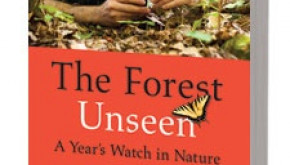
The Forest Unseen: A Year’s Watch in Nature(Penguin Books) by David George Haskell
The premise of The Forest Unseen: A Year’s Watch in Nature is simple enough, but only a naturalist like David George Haskell could write this beautiful book. Poetic and scientific, The Forest Unseen is extraordinary.
Nevertheless, I had trouble at the start with the central idea of framing a small parcel of land using the Sanskrit word “mandala,” which is defined as “a symbolic representation of the universe.” Furthermore, Haskell’s early striptease—to experience the cold in the middle of winter—seemed trite. Is this what older guys do when they are in the forest alone; take off their clothes? Wow! Still, one affords credit when Haskell concludes this about his silly act (he was almost hypothermic): “My experiences come through a body that has taken a different evolutionary path from that of the chickadees, precluding any shared experience.”
As with the mandala image, and Haskell’s nudity, at first I pictured manmade images instead of the one-square-meter patch of old-growth Tennessee forest the reader is supposed to see. But Haskell’s point is that since our natural world is constantly changing, we need to stop and observe. Haskell teaches us how. An early example:
This week’s glacial temperatures will last just a few days, but the spike in bird mortality will change the forest in ways that extend throughout the year. Deaths on winter nights check the chickadee population, trimming any birds that exceed the scant supply of winter food. Carolina chickadees each require, on average, three or more hectares of forest to sustain themselves. This square meter of mandala therefore supports just a few hundred-thousandths of a chickadee. Tonight’s cold will remove any excess.
Through forty-five short essays over the course of one year, Haskell adeptly uses a one-square-meter patch of old-growth Tennessee forest as a window onto the entire natural world, even onto human nature itself. He starts, like a well-trained naturalist, by observing wondrous details, and one never feels lost in an impenetrable landscape. Haskell writes about katydids and the music of the forest:
The rhythm holds steady for a minute or more, breaks into a din of unsynchronized songs, then unison is reestablished. The barrage of sound is the acoustic expression of the forest’s great productivity.
A finalist for the 2013 Pulitzer Prize in General Nonfiction, and winner of many awards, The Forest Unseen stresses the way we are in a relationship with the natural world and how that relationship has become skewed. How glad I am that I didn’t let my early judgment stop me from an exquisite read. Those of you who adore Leopold’s Sand County Almanac, as I do, will find a contemporary and compelling parallel in Haskell’s The Forest Unseen. It is a text grounded in reality that connects science to place, philosophy to life, and history to now.
[This book review was first published in the Idaho Forest Owners Newsletter.]

